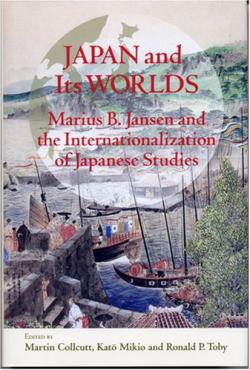Japan and its worlds: Marius Jansen and the Internationalization of Japanese Studies

Japan and its worlds: Marius Jansen and the Internationalization of Japanese Studies
Edited by Martin Collcut, Kato Mikio and Ronald P. Toby
I House Press, Tokyo, 2007, 299 pages including index, ISBN 978-4-903452-08-1
Review by Ian Nish
This is a volume of papers in honour of Marius Berthus Jansen, one of the great post-war pioneers of Japanese studies in the US, who died in 2001. Born in Holland, he emigrated to the US, served for three years during the Asia-Pacific war and then took up East Asian studies at Harvard. From 1959 he took up the chair of Japanese history at Princeton where he had been an undergraduate and taught there till his retirement. His colleagues and friends held a conference after his death and this book is a compilation of the papers presented there in his honour.
The book also contains one of Jansen’s last public papers entitled “Japan and its World” which was delivered as a keynote presentation at a conference in Kyoto in October 1994. I was fortunate enough to be present at the meeting. The other keynote speaker was Oe Kensaburo who had on that very day been awarded the Nobel Prize for Literature. Jansen’s title was, therefore, doubly symbolic. It was a session straddling a western writer analysing Japan with a Japanese writer reflecting on his life in the wider world.
Jansen’s theme was to speculate about sakoku, [鎖国,] that self-inflicted seclusion whereby Japan was for more than two centuries sealed from the outside world apart from the Dutch presence. Jansen challenges this conception, arguing that, while the Tokugawa rulers varied in their attitudes, Japan was in these centuries a regional player, having trade and cultural contacts with Korea, the Ryukyus and China and was a relatively open society until the early 19th century when the Tokugawa shogunate felt threats to their rule and clamped down on overseas contacts. So sakoku applied not to the Asian region but to Japan’s relations with the wider world. While the Japanese were in Jansen’s view quite outgoing with their neighbours, they were secretive and wanted to prevent foreigners acquiring too much knowledge of their country. That secretiveness persisted and meant that there have been even in the present day difficulties in bringing works of Japanese scholarship to the rest of the world.
Happily this book is one of the early volumes published by the new I House Press, the commercial imprint of the International House of Japan, Tokyo. I congratulate International House for taking on the task of publishing a series of English-language translations of seminal writings by Japanese scholars, which the western world badly needs. Marius Jansen spent a year (1960-1) on the staff of International House charting a course for the institution in its early days. He would have been delighted by this new publishing endeavour which will bring the fruits of Japanese research and thinking to a wider readership.
This volume contains essays of the highest quality which advance our knowledge considerably in the central areas of modern Japanese history which were of interest to Jansen. They are a fitting tribute to a great teacher who was always reaching out to general readers in the US and Japan and trying to increase understanding between them. The world is the gainer from them.

